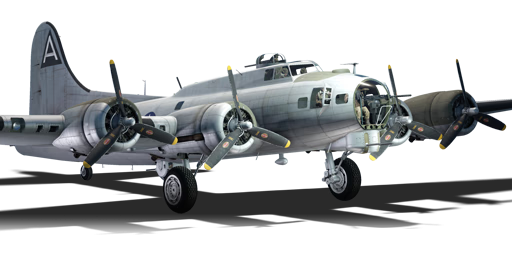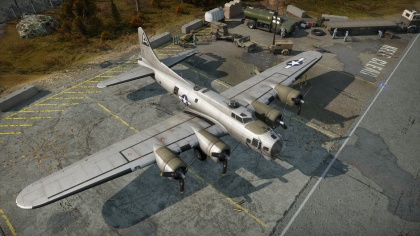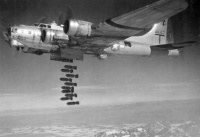Difference between revisions of "B-17G-60-VE"
m (→Suspended armament) |
(→Usage in the battles) |
||
| Line 175: | Line 175: | ||
* 1 x 12.7 mm Browning M2 Browning machine gun, 2 x cheek turret, 300 rpg | * 1 x 12.7 mm Browning M2 Browning machine gun, 2 x cheek turret, 300 rpg | ||
| − | == Usage in the battles == | + | ==Usage in the battles== |
<!--''Describe the tactics of playing in an aircraft, the features of using vehicles in a team and advice on tactics. Refrain from creating a "guide" - do not impose a single point of view but give the reader food for thought. Examine the most dangerous enemies and give recommendations on fighting them. If necessary, note the specifics of the game in different modes (AB, RB, SB).''--> | <!--''Describe the tactics of playing in an aircraft, the features of using vehicles in a team and advice on tactics. Refrain from creating a "guide" - do not impose a single point of view but give the reader food for thought. Examine the most dangerous enemies and give recommendations on fighting them. If necessary, note the specifics of the game in different modes (AB, RB, SB).''--> | ||
When facing fighters and interceptors in Realistic Battles, it is best to use Omni-purpose or Armour-piercing/Ground Target ammunition belts for the 12.7 mm M2 Browning machine guns. These ammunition belts are effective at tearing through the engine block and hopefully resulting in an internal engine fire. You maybe also able to score a pilot kill on your opponent. | When facing fighters and interceptors in Realistic Battles, it is best to use Omni-purpose or Armour-piercing/Ground Target ammunition belts for the 12.7 mm M2 Browning machine guns. These ammunition belts are effective at tearing through the engine block and hopefully resulting in an internal engine fire. You maybe also able to score a pilot kill on your opponent. | ||
| Line 192: | Line 192: | ||
{| class="wikitable" style="text-align:center" | {| class="wikitable" style="text-align:center" | ||
|- | |- | ||
| − | ! colspan="7" | MEC elements | + | ! colspan="7"|MEC elements |
|- | |- | ||
| − | ! rowspan="2" |Mixer | + | ! rowspan="2"|Mixer |
| − | ! rowspan="2" |Pitch | + | ! rowspan="2"|Pitch |
| − | ! colspan="3" |Radiator | + | ! colspan="3"|Radiator |
| − | ! rowspan="2" |Supercharger | + | ! rowspan="2"|Supercharger |
| − | ! rowspan="2" |Turbocharger | + | ! rowspan="2"|Turbocharger |
|- | |- | ||
! Oil | ! Oil | ||
| Line 204: | Line 204: | ||
! Type | ! Type | ||
|- | |- | ||
| − | | Controllable || rowspan="2" | Not controllable || rowspan="2" | Not controllable || rowspan="2" | Not controllable || rowspan="2" | Separate || rowspan="2" | Not | + | | Controllable || rowspan="2" | Not controllable || rowspan="2" | Not controllable || rowspan="2" | Not controllable || rowspan="2" | Separate || rowspan="2" | Not controllable || rowspan="2" | Not controllable |
|- | |- | ||
|} | |} | ||
| Line 210: | Line 210: | ||
===Modules=== | ===Modules=== | ||
{| class="wikitable" | {| class="wikitable" | ||
| − | ! | + | ! Tier |
| − | !colspan = "2"| Flight performance | + | ! colspan = "2"|Flight performance |
| − | ! | + | ! Survivability |
| − | !colspan = "2"| Weaponry | + | ! colspan = "2"|Weaponry |
|- | |- | ||
| I | | I | ||
| − | | Fuselage Repair | + | | Fuselage Repair||Radiator |
| − | | Radiator | + | | Protective vest |
| − | | | + | | Turret 12 mm||LBC-17 |
| − | | Turret 12 mm | ||
| − | | LBC-17 | ||
|- | |- | ||
| II | | II | ||
| − | | | + | | ||Compressor |
| − | | Compressor | ||
| Airframe | | Airframe | ||
| − | | | + | | ||SBC-17 |
| − | | SBC-17 | ||
|- | |- | ||
| III | | III | ||
| − | | Wings | + | | Wings repair||Engine |
| − | | Engine | + | | |
| − | | | + | | New 12 mm MGs (turret)||MBC-17 |
| − | | New 12 mm MGs (turret) | ||
| − | | MBC-17 | ||
|- | |- | ||
| IV | | IV | ||
| | | | ||
| − | | Engine Injection | + | | ||Engine Injection |
| Cover | | Cover | ||
| − | + | | M10 bomb rack | |
| − | | M10 | ||
|- | |- | ||
|} | |} | ||
| Line 247: | Line 240: | ||
*This slow and lumbering heavy bomber relies entirely on its turrets for defense. Without it the plane is target practice. Thus "Protective vests" should be the first unlock. Further survivability upgrades will make the fight easier, but do not think it will successfully face-off against enemy fighters. So upgrading the bomb payloads should be second priority. Performance modules can be considered least necessary. | *This slow and lumbering heavy bomber relies entirely on its turrets for defense. Without it the plane is target practice. Thus "Protective vests" should be the first unlock. Further survivability upgrades will make the fight easier, but do not think it will successfully face-off against enemy fighters. So upgrading the bomb payloads should be second priority. Performance modules can be considered least necessary. | ||
| − | === Pros and cons === | + | ===Pros and cons=== |
<!--''Summarize and briefly evaluate the vehicle in terms of its characteristics and combat effectiveness. Mark its pros and cons in the bulleted list. Do not use more than 6 points for each of the characteristics. Avoid using categorical definitions such as "bad", "good" and the like - they have a substitution in the form of softer "inadequate", "effective".''--> | <!--''Summarize and briefly evaluate the vehicle in terms of its characteristics and combat effectiveness. Mark its pros and cons in the bulleted list. Do not use more than 6 points for each of the characteristics. Avoid using categorical definitions such as "bad", "good" and the like - they have a substitution in the form of softer "inadequate", "effective".''--> | ||
'''Pros:''' | '''Pros:''' | ||
* Large bomb payload | * Large bomb payload | ||
| − | * Powerful air | + | * Powerful air defense capabilities |
* Multiple engines | * Multiple engines | ||
* Overall heavily armoured | * Overall heavily armoured | ||
Revision as of 03:56, 11 March 2019
Contents
| This page is about the aircraft B-17G-60-VE. For other uses, see B-17 (Disambiguation) |
Description
The B-17G-60-VE Flying Fortress is a Rank IV American bomber with a battle rating of 6.0 (AB/RB) and 6.7 (SB). It was in the game since the start of the Open Beta Test prior to Update 1.29.
The B-17G Flying Fortress, as the name suggests, is intended to be used as a high-altitude level bomber, designed to target enemy airfields and military bases. Despite its large bomb-load, it is not recommended to target moving ground targets such as tank formations. This due to the inaccuracy of bombs being released at high altitude. When using the B-17G, it is always best to group up with others in a wedge-like formation for optimal defense. The higher you climb the harder of a target you will become. A few fighter escorts, such as a squadron of P-51 Mustangs would ensure the survival of friendly bombers. Survival is an utmost importance to be remembered when using this plane. While you may miss one target, you can always make another pass once you reload and repair.
General info
Flight Performance
| Characteristics | |||||||
|---|---|---|---|---|---|---|---|
| Stock | |||||||
| Max Speed (km/h at 7,680 m) |
Max altitude (meters) |
Turn time (seconds) |
Rate of climb (meters/second) |
Take-off run (meters) | |||
| AB | RB | AB | RB | AB | RB | ||
| 491 | 476 | 11,156 | 37.5 | 38.2 | 2.2 | 2.2 | 600 |
| Upgraded | |||||||
| Max Speed (km/h at 7,680 m) |
Max altitude (meters) | Turn time (seconds) | Rate of climb (meters/second) |
Take-off run (meters) | |||
| AB | RB | AB | RB | AB | RB | ||
| ? | ? | 11,156 | ??.? | ??.? | ?.? | ?.? | ? |
Details
| Features | ||||
|---|---|---|---|---|
| Combat flap | Take-off flap | Landing flap | Air brakes | Arrestor gear |
| ✓ | ✓ | ✓ | X | X |
| Limits | ||||
|---|---|---|---|---|
| Wing-break speed (km/h) |
Gear limit (km/h) |
Combat flap (km/h) |
Max Static G | |
| + | - | |||
| 360 | 300 | 323 | ~1 | ~1 |
| Optimal velocities | |||
|---|---|---|---|
| Ailerons (km/h) |
Rudder (km/h) |
Elevators (km/h) |
Radiator (km/h) |
| < 360 | < 300 | < 323 | > 310 |
| Compressor (RB/SB) | ||
|---|---|---|
| Setting 1 | ||
| Optimal altitude | 100% Engine power | WEP Engine power |
| 6,180 m | 4,000 hp | 4708 hp |
Survivability and armour
- 6.35 mm Steel - Lower nose armor plate
- 6.35 mm Steel - Back of pilot and co-pilot's seats
- 6.35 mm Steel - Dorsal turret gunner protective plate
- 6.35 mm Steel - Radio operator protective plate
- 6.35 mm Steel - Beam gunner protective armor x 2
- 6.35 mm Steel - Tail gunner protective plate
- 38 mm Bulletproof glass - Ball turret
- 38 mm Bulletproof glass - Tail gunner rear window
Armaments
Suspended armament
The B-17G-60-VE can be outfitted with the following ordinance:
- 8 x 500 lb bombs (4,000 lb total)
- 12 x 500 lb bombs (6,000 lb total)
- 6 x 1000 lb bombs (6,000 lb total)
- 8 x 1000 lb bombs (8,000 lb total)
- 2 x 2000 lb bombs (4,000 lb total)
- 4 x 2000 lb bombs (8,000 lb total)
Defensive armament
The B-17G-60-VE is defended by:
- 2 x 12.7 mm Browning M2 Browning machine gun, tail turret, 575 rpg
- 2 x 12.7 mm Browning M2 Browning machine gun, front dorsal turret, 500 rpg
- 1 x 12.7 mm Browning M2 Browning machine gun, rear dorsal turret, 500 rpg
- 2 x 12.7 mm Browning M2 Browning machine gun, ventral turret, 500 rpg
- 2 x 12.7 mm Browning M2 Browning machine gun, chin turret, 400 rpg
- 1 x 12.7 mm Browning M2 Browning machine gun, 2 x beam turret, 600 rpg
- 1 x 12.7 mm Browning M2 Browning machine gun, 2 x cheek turret, 300 rpg
Usage in the battles
When facing fighters and interceptors in Realistic Battles, it is best to use Omni-purpose or Armour-piercing/Ground Target ammunition belts for the 12.7 mm M2 Browning machine guns. These ammunition belts are effective at tearing through the engine block and hopefully resulting in an internal engine fire. You maybe also able to score a pilot kill on your opponent.
Specific enemies worth noting
B-17s are notoriously hard to kill when compared to similar Soviet and German bombers. However, with the B-17 the best defense is to evade your opponent altogether. Your worst enemies will be almost all fighters due to the high BR (FW-190 D, Ta-152, BF-109 G-10/K-4, F8F-1B, Tempest, etc.). Most fighters will have 2-4 cannons which can still make short work of the B-17.
NOTE: The weakest area of approach with the B-17G is the front. Only 1-2 MGs can be focused directly forward if a fighter head-ons you. The crew is also focused at the nose. If there is a fighter at your level , try to turn and expose the tail "barb". Diving may work as well. However, diving can put you into more danger as more fighters may swarm you.
Counter-tactics
When climbing to fight the B-17, you will most likely have a lower energy level depending on the plane you use. The F8F-1B, for example, has an extremely good acceleration with WEP and can climb ridiculously quickly as well. If in a plane such as an F8F-1B, attempt to head on the B-17 as this is the weakest point. If the B-17 turns away, climb and chase the Flying Fortress at a higher altitude and then dive on it from an angle. Always avoid tailing a B-17, regardless of model. This just warrants a knocked-out pilot or fire.
Manual Engine Control
| MEC elements | ||||||
|---|---|---|---|---|---|---|
| Mixer | Pitch | Radiator | Supercharger | Turbocharger | ||
| Oil | Water | Type | ||||
| Controllable | Not controllable | Not controllable | Not controllable | Separate | Not controllable | Not controllable |
Modules
| Tier | Flight performance | Survivability | Weaponry | ||
|---|---|---|---|---|---|
| I | Fuselage Repair | Radiator | Protective vest | Turret 12 mm | LBC-17 |
| II | Compressor | Airframe | SBC-17 | ||
| III | Wings repair | Engine | New 12 mm MGs (turret) | MBC-17 | |
| IV | Engine Injection | Cover | M10 bomb rack | ||
- This slow and lumbering heavy bomber relies entirely on its turrets for defense. Without it the plane is target practice. Thus "Protective vests" should be the first unlock. Further survivability upgrades will make the fight easier, but do not think it will successfully face-off against enemy fighters. So upgrading the bomb payloads should be second priority. Performance modules can be considered least necessary.
Pros and cons
Pros:
- Large bomb payload
- Powerful air defense capabilities
- Multiple engines
- Overall heavily armoured
Cons:
- Big target
- Fairly Slow
- Nose is extremely vulnerable for the pilot and crew
- Vulnerable to German "Minengeschoße" and >20 mm gunfire
- Engine fires are common
- Wings are big and thus commonly torn off by gunfire
- Aggressive turns may snap wings
- All fuel tanks are located in the wings, and are prone to catching fire and damaging/destroying wings
History
Due to direct experience from U.S. Bomber crews in 1943, the B-17F revealed inadequate protection from head on attacks by enemy fighters. The primary change introduced with the B-17G was the remote controlled chin turret armed with two 12.7 mm M2 Browning machine guns. This new addition proved to be more practical than manual operated guns initially fitted to the nose. The B-17G began delivery in September of 1943 and included various upgrades throughout its production. A total of 8,680 aircraft were built from three manufacturers until April of 1945. The B-17G could be considered the corner stone of U.S. bombing efforts in the European theater between 1944 and 1945.
Media
An excellent addition to the article will be video guides, as well as screenshots from the game and photos.
Read also
Links to the articles on the War Thunder Wiki that you think will be useful for the reader, for example,
- reference to the series of the aircraft;
- links to approximate analogues of other nations and research trees.
Sources
Paste links to sources and external resources, such as:
- topic on the official game forum;
- page on aircraft encyclopedia;
- other literature.
| USA bombers | |
|---|---|
| Dive | SB2U-2 · SB2U-3 · SBD-3 · SB2C-1C · SB2C-4 |
| Torpedo | TBD-1 · PBY-5 Catalina · PBY-5A Catalina · TBF-1C · BTD-1 |
| Medium | B-10B · B-18A · B-34 · PV-2D · B-25J-1 · B-25J-20 · A-26C-45 · A-26C-45DT · B-26B |
| Heavy | B-17E · B-17E/L · B-17G-60-VE · PB4Y-2 · B-24D-25-CO · B-29A-BN |
| Hydroplanes | OS2U-1 · OS2U-3 · PBM-1 "Mariner" · PBM-3 "Mariner" · PBM-5A "Mariner" |






